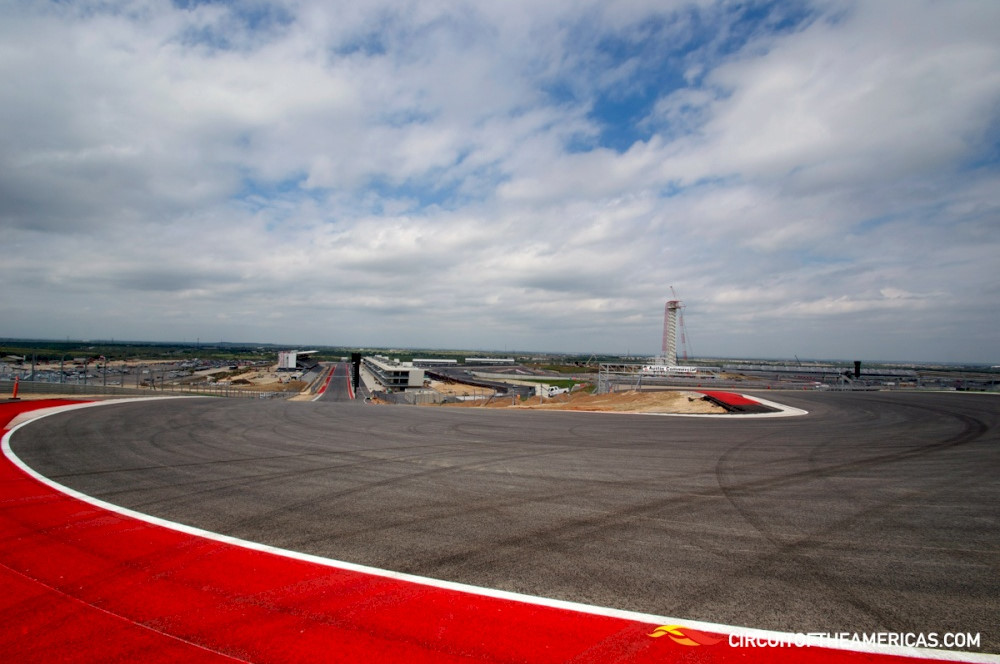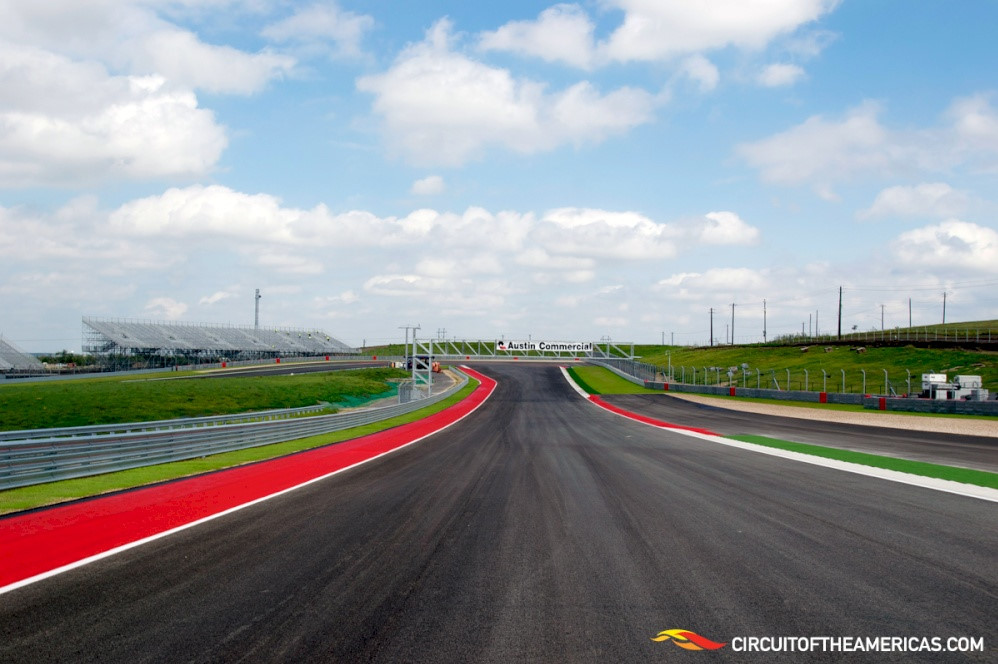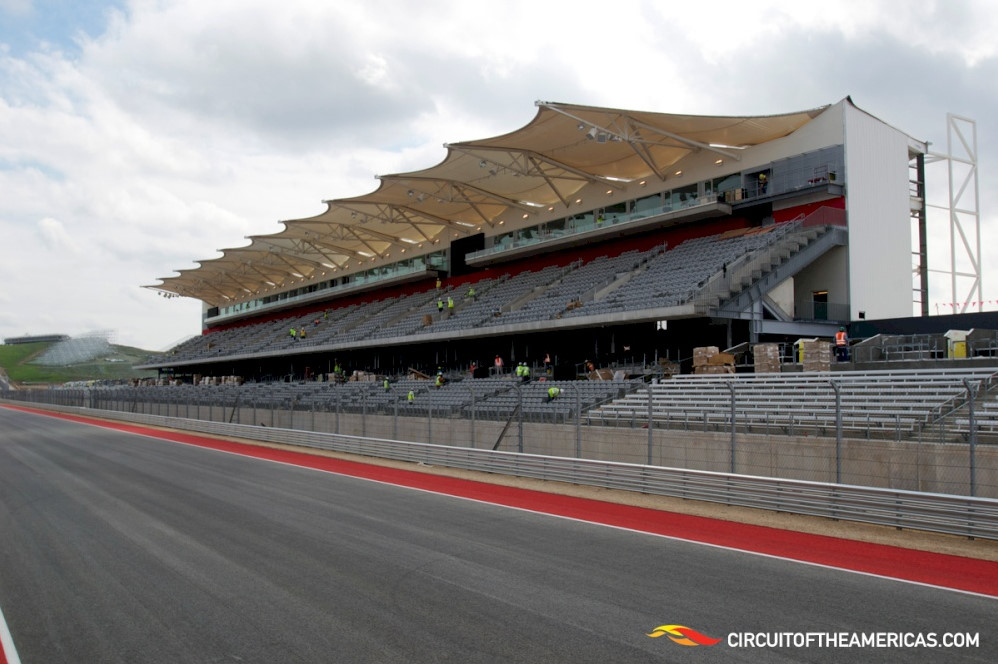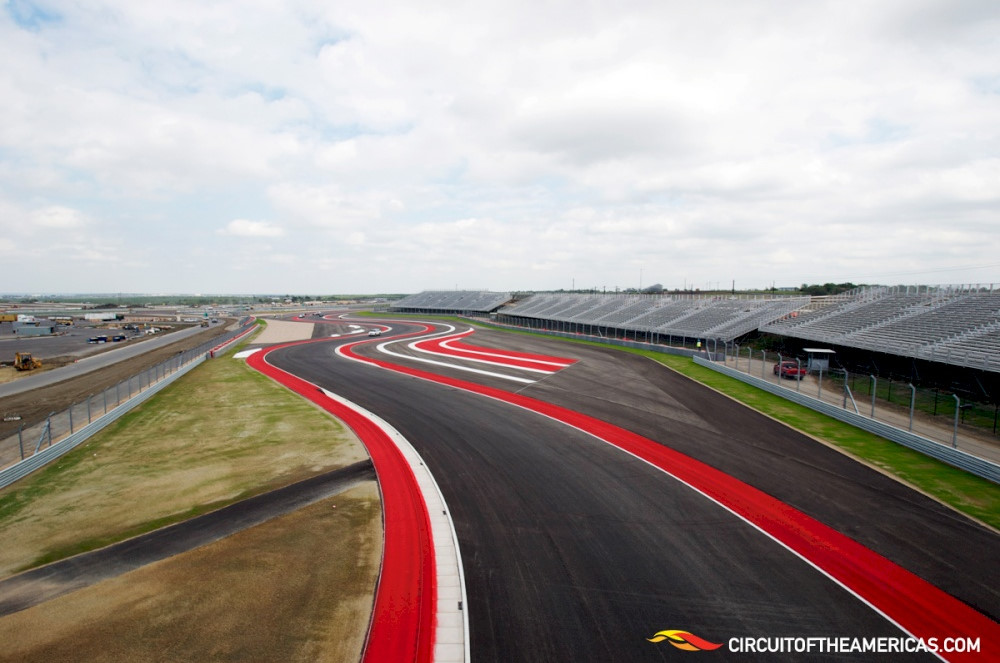Against all odds, F1 track has been built, ready to host race
 |
| Top of turn 1 looking back at S/F line |
This week, Austin joins 19 other cities such as Monaco, Shanghai and Sao Paulo on the exclusive, glamorous international stage of Formula One racing.
Just southeast of the city, on a tract of land that was home to rabbits and rattlesnakes just 30 months ago, more than a hundred thousand spectators are expected to watch as some of the world’s fastest, most technologically advanced cars scream around a dazzling, new 3.4-mile racing circuit.
The Circuit of The Americas hosts the United States Grand Prix. Gov. Rick Perry said the race and the racing facility are “an opportunity to change Texas forever."
It’s an improbable project that has drawn skepticism since it was announced in May 2010. Many people said it would never happen. Too ambitious. Too expensive. Too little time. Too unlike Austin.
 |
| Hard braking downhill for the turn 11 lefthander |
For almost two years, the project has bumped and lurched through doubts and delays. On at least two occasions, organizers say, the project was a heartbeat away from failure. Even last week, race workers were still scrambling around the massive site to complete a critical access road and finish fan amenities.
And yet against all challenges and odds, the track has been built, and both the design and workmanship have been drawing raves.
The story of how circuit developers overcame obstacle after obstacle is improbable, dramatic and sometimes contentious. The two main players, Bobby Epstein and Tavo Hellmund, are no longer partners, and they don’t agree on much of anything.
The one thing on which they do concur is that they have created something special for their hometown.
“It’s something everybody can be proud of," said Hellmund.
 |
| Main Grandstands |
“It might be one of the greatest construction stories since the Empire State Building," said Epstein, who wasn’t joking.
***
Hellmund is the dreamer. His father, Gustavo, was a promoter who helped bring Formula One racing to Mexico in the 1980s when Tavo was a teenager.
Tavo was immersed in the sport and the culture, and he spent a few months working as a gofer for the Brabham team owned by Bernie Ecclestone. Over time, he dreamed of designing a track of his own. He made a sketch of his dream, incorporating some of the best features of tracks around the world from Istanbul to Great Britain.
And he stayed in touch with Ecclestone as he moved from team owner to the director of all Formula One racing, with power that even an NFL commissioner would envy.
From time to time, Hellmund would casually pitch Austin to Ecclestone as a potential F1 site, touting its music scene, youth and flair as well as its proximity to Houston, Dallas and San Antonio. Ecclestone wasn’t impressed, Hellmund says.
“He thought it was still the sleepy little hippie town it was 30 years ago," Hellmund said. About the only attraction for Ecclestone was the city’s lack of major league sports, Hellmund said. In other words, the would be little competition for an audience.
 |
| Esses |
When Indianapolis and Formula One parted ways in 2007 after eight years of racing, Hellmund began lobbying Ecclestone in earnest and working on the sketches of his dream track .
Intensifying the effort, Hellmund began to look for a place to develop a track. He figured it would require at least 600 acres and that it should be close to a major highway and an airport. It needed to be affordable, too.
He discreetly looked at areas like Wildhorse Ranch and Villa Muse.
Then he heard from real estate investor Kam Kronenberg about an undeveloped 647-acre tract of land near Elroy. Kronenberg said it was being held for a possible housing development called Wandering Creek, and he suggested that Hellmund talk with his partner, Bobby Epstein.
Epstein founded his Austin-based private investment firm, Prophet Capital Management, in 1995. His specialty has been investments, not real estate.
Hellmund said the two first met briefly at a lunch at Austin Country Club and that neither he nor Epstein was enthusiastic about a potential fit.
Hellmund said when he first saw the property he hadn’t been impressed. Looking out from McAngus Road, the tract was pretty flat, a big problem since he wanted his dream Turn 1 to have a dramatic change in elevation.
“I kind of blew it off. We were so focused on Wildhorse," Hellmund said of the tract
As a potential investor, Epstein initially had trouble getting his head around Hellmund’s dream. “I don’t want to call it crazy," he recalled, “but I thought it was far-fetched."
And yet, a seed had been planted.
The seed began to grow when Hellmund successfully pitched his idea to Texas Comptroller Susan Combs. Hellmund was angling for state incentive funding designed to attract and promote major events like the Super Bowl.
After a series of meetings with Hellmund, Combs wrote to Ecclestone in May 2010 offering $25 million from the state’s Major Events Trust Fund for 10 years. The gamble for the state is that the investment would be more than repaid by the added sales tax revenues generated by an event that would attract more than 100,000 fans, many of whom would stay in the area for three or four days.
The $25 million figure was important, since that is close to the annual licensing or sanctioning fee for a city like Austin to have the privilege of being on the Formula One annual racing circuit.
Ecclestone was now interested. And so was Epstein.
“If you have help offsetting the sanctioning fee," he said, “then it can survive."
Epstein put up the Wandering Creek parcel, and some additional funds. San Antonio billionaire Red McCombs was brought on board to give the project both professional sports and big league financial credibility. Adjacent parcels of land were added, including one with a big hill for Hellmund’s Turn 1.
At a July 2010 press conference in Austin, the site location was revealed, and McCombs quickly announced that he was looking for investors.
As Epstein listened, he envisioned his role as support, as he put it “the guy in the bleachers cheering Tavo and Red on."
It wouldn’t work out that way.
In the fall of 2010, Epstein said a handful of the top project investors and officials had a dinner during which they cast ballots to pick a general contractor from a few finalists. Epstein said the decision wasn’t unanimous but that Dallas-based Austin Commercial was the winner. Hellmund said he was allowed to cast the deciding vote — with the unspoken message that he’d better be right.
“I don’t think any of us realized how important that (decision) would be," said Epstein, adding that managing the project, “was like having 35 subcontractors working on your house."
Epstein says, “People tell me if I would have known anything about real estate I would have known it (the project) couldn’t be done."
The site presented challenges from the beginning. One of the biggest was one of the first: stabilize the black clay soil on the site so a reliable track could be built. Black clay expands and contracts dramatically depending on moisture.
“That’s like building a three and one-half mile bridge," one person familiar with construction east of Austin said before the project began.
Engineers from the German engineering firm of Tilke GmbH, who have worked on almost all recent Formula One tracks, recommended a deeper than normal base for the track. They recommended digging to 9 feet. According to construction reports almost 4 million cubic yards of earth were moved for the project — roughly enough to fill up the Empire State Building three times.
Epstein said that even if that excavation cost $15 million, it was still much cheaper to do that than buy bedrock land that would have cost perhaps 10 times as much.
“This was $5,000 to $15,000 an acre," Epstein said of the Elroy plot.
There were also a couple of underground gas pipelines to relocate and a slew of county permits to obtain before construction could begin.
But the biggest obstacle to the project was a behind-the-scenes rift between Hellmund and Epstein and McCombs. The original plan had been for Hellmund to be a partner in the project based on two important factors. The idea and general track plan were his, and the Formula One licensing agreement to run a race in Austin was in his control.
This rift showed up in a notable lack of progress at the construction site and in a shift in race timing.
Originally, the inaugural race was scheduled for June 2012, and it showed up that way on the Formula One provisional calendar for 2012. But even as that news was coming out, there was talk of moving the race date to late in the year.
Although there was speculation that the move was for weather reasons, it had more to do with a missed deadline for the Austin group to settle an agreement with Ecclestone and to pay the sanctioning fee.
To settle the issue with Hellmund, Epstein and his partners agreed to an $18 million buyout and Hellmund agreed to assign his contract with Formula One to the circuit developers. That was in September 2011, which was dangerously close to the final decision for a final 2012 racing calendar.
In late October, Epstein and the Circuit of the Americas’ president, Steve Sexton, flew to London to meet with Ecclestone. Hellmund also attended that meeting.
“The conference room was small, it would be cramped for eight people," Epstein said. “He (Ecclestone) was right to the point and very quick-witted."
At that point, there was no contract for an F1 race in Austin. Ecclestone, who had voided Hellmund’s contract for lack of payment, offered a “similar" contract to Epstein.
Epstein said he looked at it, focused on the higher-than-expected annual sanctioning fees over a 10-year period and thought: This deal is dead.
“I read it and gave it back," Epstein recalled.
Ecclestone suggested Epstein take a copy.
“I don’t need a copy, I know what it said. It’s a deal-killer," Epstein said.
Sexton persuaded to Epstein to hold off a final judgment, the meeting ended and they returned to Austin. Epstein said recently he wouldn’t have given the project a 5 percent chance of survival at that point.
Two weeks later, in mid-November, construction halted at the track and 300 workers took their tools and heavy machinery to look for work elsewhere.
And Epstein was soul searching. “When it hit the fan, when it was laying on the ground, I felt like I couldn’t let it fail," Epstein said of the project. He explained that he didn’t think he’d have a chance in his lifetime to make as big an economic impact in the community where he lived.
“It’s one thing to give away money to charities; it’s another to create something sustainable," Epstein said.
He won’t say whether he negotiated adjustments to the contract or the sanctioning fee, but what Epstein did do was come to terms with Ecclestone. It was literally at the 11th hour, done just before Ecclestone walked into a meeting in New Delhi to set the final 2012 Formula One calendar.
When Ecclestone came out of the meeting, Austin’s inaugural race was listed on Nov. 18.
Then, the real scramble began.
“It was almost like starting over, hitting the reset button," Epstein said.
Workers returned to the site and began working double shifts late into the night to catch up. Earth was moved. Foundations were poured. Buildings began to rise.
The plans kept changing. An amphitheater for concerts was added, moving the project from a motorsports complex to an entertainment facility.
One of the biggest challenges was, and continues to be, access to the rural site. In addition to improving some existing roads, the investors bought two more large parcels of land on the north side of the track and extended Kellam Road 0.6 of a mile to provide another way to get to the track from the north.
Although much of the land near the track is scrub forest, the entrance from Pearce Lane to Kellam Road is scenic.
“It may be the ultimate front door," Epstein said.
With barely a day to spare, a most improbable project is ready for the big race. The Statesman
